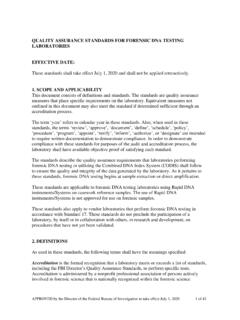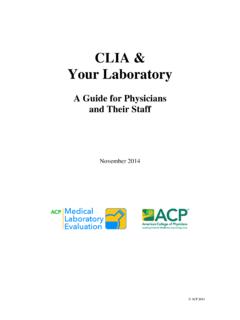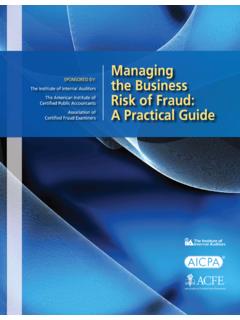Transcription of FORENSIC TOXICOLOGY LABORATORY GUIDELINES
1 SOFT / AAFS FORENSIC LABORATORY GUIDELINES 2006 1. SOFT / AAFS. FORENSIC TOXICOLOGY . LABORATORY GUIDELINES . 2006 VERSION. 1. INTRODUCTION. The FORENSIC TOXICOLOGY LABORATORY GUIDELINES were originally published in 1991 as two main documents ( GUIDELINES plus Appendix), plus the self-evaluation checklist. The primary document, the GUIDELINES , was initially drafted in response to the growth and regulation of FORENSIC urine drug testing. It was an attempt to take the important issues that were addressed for Federal Workplace Drug Testing Programs and draft them into terms which could be more realistically applied to the areas of Post-Mortem FORENSIC TOXICOLOGY and Human-Performance FORENSIC TOXICOLOGY . However, the GUIDELINES Committee agreed that there were many additional issues which were important to cover, but which might better belong in a supplementary document - the Appendix to the GUIDELINES . Since 1991, the profession has matured in many ways.
2 In 1996 the American Board of FORENSIC TOXICOLOGY launched a FORENSIC TOXICOLOGY Accreditation program based primarily on the SOFT/AAFS GUIDELINES and Appendix. In 1997 New York State passed legislation requiring the accreditation of all FORENSIC laboratories in the public sector, and others may follow. The GUIDELINES Committee concluded that it was time to redraft the original GUIDELINES and Appendix into a single cohesive document which would be easier to reference and to update in the future. That was done, and the final document approved and adopted. Subsequent changes to the format and content were made and approved in 1998, 2000, 2002 and 2006. Introduction from 1991 GUIDELINES In response to the GUIDELINES for Federal Workplace Drug Testing Programs issued by the U. S. Department of Health and Human Services in 1987, the Society of FORENSIC Toxicologists and the TOXICOLOGY Section of the American Academy of FORENSIC Sciences appointed a joint committee of members to recommend a supplementary set of GUIDELINES for the practice of FORENSIC TOXICOLOGY .
3 The federal GUIDELINES , especially with respect to LABORATORY personnel and operating procedures, may not always be appropriate for other types of FORENSIC TOXICOLOGY , and the GUIDELINES set forth below represent recommendations of the Society/Academy committee in response to that issue. These suggestions do not necessarily reflect opinions about the minimum requirement for any LABORATORY , and have no regulatory purpose; rather, they are intended to assist laboratories engaged in the practice of FORENSIC TOXICOLOGY in achieving future goals. SOFT / AAFS FORENSIC LABORATORY GUIDELINES 2006 2. 2. SCOPE. The original committee concluded that specific GUIDELINES for the practice of FORENSIC TOXICOLOGY would be appropriate for two defined areas: Post-Mortem FORENSIC TOXICOLOGY and Human Performance FORENSIC TOXICOLOGY . The committee concluded that it was not appropriate to include FORENSIC Urine Drug Testing, because that area of practice has been covered by the Department of Health and Human Services GUIDELINES and by the College of American Pathologists Accreditation program.
4 The specific aims of the committee, with respect to postmortem and human-performance FORENSIC TOXICOLOGY , were to provide detailed GUIDELINES for LABORATORY practices and to prepare a checklist for self-evaluation that may also serve as an important component of a program designed to prepare a LABORATORY for accreditation. The self-evaluation checklist has since been dropped after it was adopted and expanded by the American Board of FORENSIC TOXICOLOGY as part of their LABORATORY accreditation program in 1996. 3. DEFINITIONS. Post-Mortem FORENSIC TOXICOLOGY - determines the absence or presence of drugs and their metabolites, chemicals such as ethanol and other volatile substances, carbon monoxide and other gases, metals, and other toxic chemicals in human fluids and tissues, and evaluates their role as a determinant or contributory factor in the cause and manner of death;. Human-Performance FORENSIC TOXICOLOGY - determines the absence or presence of ethanol and other drugs and chemicals in blood, breath or other appropriate specimen(s), and evaluates their role in modifying human performance or behaviour.
5 (The analysis of ethanol in breath, although important, was not considered by the committee because such tests are not conducted in a LABORATORY setting); and FORENSIC Urine Drug Testing - determines the absence or presence of drugs and their metabolites in urine to demonstrate prior use or abuse. Standard - a reference material possessing one or more properties that are sufficiently well established that it can be used to prepare calibrators. Calibrator - a solution , either prepared from the reference material or purchased, used to calibrate the assay. Where possible, calibrators should be prepared in a matrix similar to that of the specimens. Control - a solution either prepared from the reference material (separately from the calibrators;. that is, weighed or measured separately), purchased, or obtained from a pool of previously analyzed samples. Controls from any of these sources are used to determine the validity of the calibration; that is, the stability of a quantitative determination over time.
6 Where possible, controls should be matrix-matched to specimens and calibrators, as indicated above. SOFT / AAFS FORENSIC LABORATORY GUIDELINES 2006 3. Reference Material (RM) - a material or substance one or more properties of which are established sufficiently well to be used for calibration of an apparatus, assessing a measurement or assigning values to material. (AOAC Official Methods of Analysis (1984)). Certified Reference Material (CRM) - a reference material, one or more of whose properties are certified by a valid procedure, or accompanied by or traceable to a certificate or other documentation which is issued by a certifying body. (AOAC Official Methods of Analysis (1984)). 4. PERSONNEL. LABORATORY Director The FORENSIC TOXICOLOGY LABORATORY should be directed by a person who is qualified by reason of appropriate education and experience to assume the required professional, organizational, educational, managerial and administrative responsibilities.
7 That education and experience should be comparable to those of persons certified as Diplomates by the American Board of FORENSIC TOXICOLOGY . Alternative acceptable qualifications include a doctoral degree in one of the natural sciences and at least three years of full-time LABORATORY experience in FORENSIC TOXICOLOGY ; or a Master's degree in one of the natural sciences and at least five years of full-time LABORATORY experience in FORENSIC TOXICOLOGY ; or a Bachelor's degree in one of the natural sciences and at least seven years of full-time LABORATORY experience in FORENSIC TOXICOLOGY . The director should also have documented training and/or experience in the FORENSIC applications of analytical TOXICOLOGY (such as court testimony, research, participation in continuing education programs, and/or peer review of appropriate manuscripts in the field), including a knowledge of evidentiary procedures that apply when toxicological specimens are acquired, processed, and stored and when toxicological data are submitted as part of a legal proceeding.
8 The LABORATORY director should be responsible for ensuring that the LABORATORY personnel are adequately trained and experienced to conduct the work of the LABORATORY The LABORATORY director should be responsible for maintaining the competency of LABORATORY personnel by monitoring their work performance and verifying their skills. This training and experience should be documented. The LABORATORY director should be responsible for the development of a complete, up-to-date procedures manual that is available to and followed by all personnel performing tests. The LABORATORY director should establish a procedure for validating new analytical methodologies, and for maintaining a quality assurance program to ensure the proper performance and reporting of all test results. SOFT / AAFS FORENSIC LABORATORY GUIDELINES 2006 4. Since FORENSIC TOXICOLOGY laboratories handle controlled substances and generate results essential to the criminal justice system, the director, to the extent practical or permitted by law, should exert reasonable efforts to ensure that all personnel meet high ethical and moral standards .
9 Other LABORATORY Staff The range and type of duties of other LABORATORY personnel will vary according to the size and the scope of the LABORATORY . It is recommended that each LABORATORY should have the following. A person with the title of deputy director, assistant LABORATORY director, assistant chief toxicologist, or supervisory toxicologist, who has sufficient training and experience to be familiar with all administrative and testing procedures. He or she may supervise the work of all analysts, and should be capable of performing full scientific review of all test data, and of acting for the LABORATORY director in the director's absence. It is recommended that such individuals should have a minimum of a Bachelors degree in a natural science and 3 years of training in analytical TOXICOLOGY , at least 1 year of which is in FORENSIC TOXICOLOGY . One or more technicians who are capable of performing a variety of test procedures for alcohol, drugs, and other chemicals.
10 A technician may supervise and review the work of less experienced technicians, and may supervise a section in a larger LABORATORY . It is recommended that such individuals should have a minimum of a Bachelor's degree in a natural science, at least 1 year of experience in analytical TOXICOLOGY and 6 months experience in the present employment. One or more analysts who are capable of performing tests for one or several analytes, and who are certified in each procedure by the LABORATORY director. These analysts may be limited in function to perform specified tasks - for example, an analyst who performs only immunoassays. 5. STANDARD OPERATING PROCEDURES. The LABORATORY should have a standard operating procedure manual (SOP) that is complete, up-to-date, and available to all personnel who are performing tests. The SOP manual should include detailed descriptions of procedures for sample receiving, accessioning, chain-of-custody, analysis, quality assurance and quality control, review of data, and reporting.






